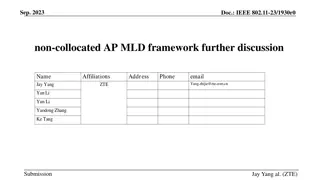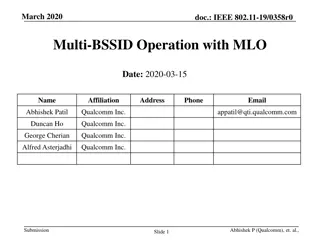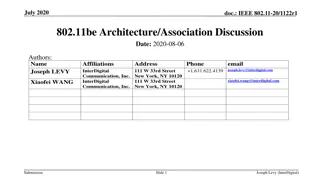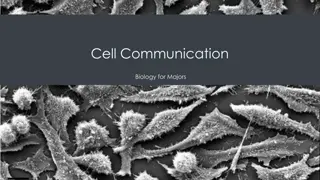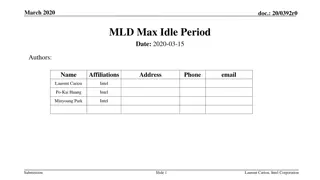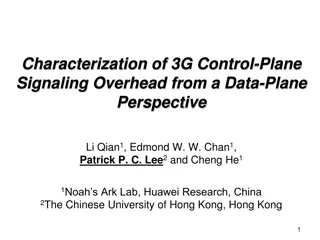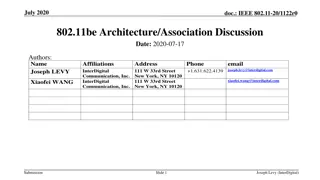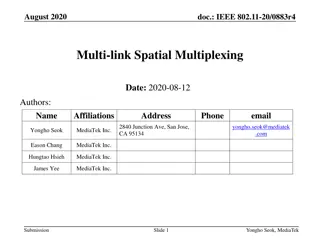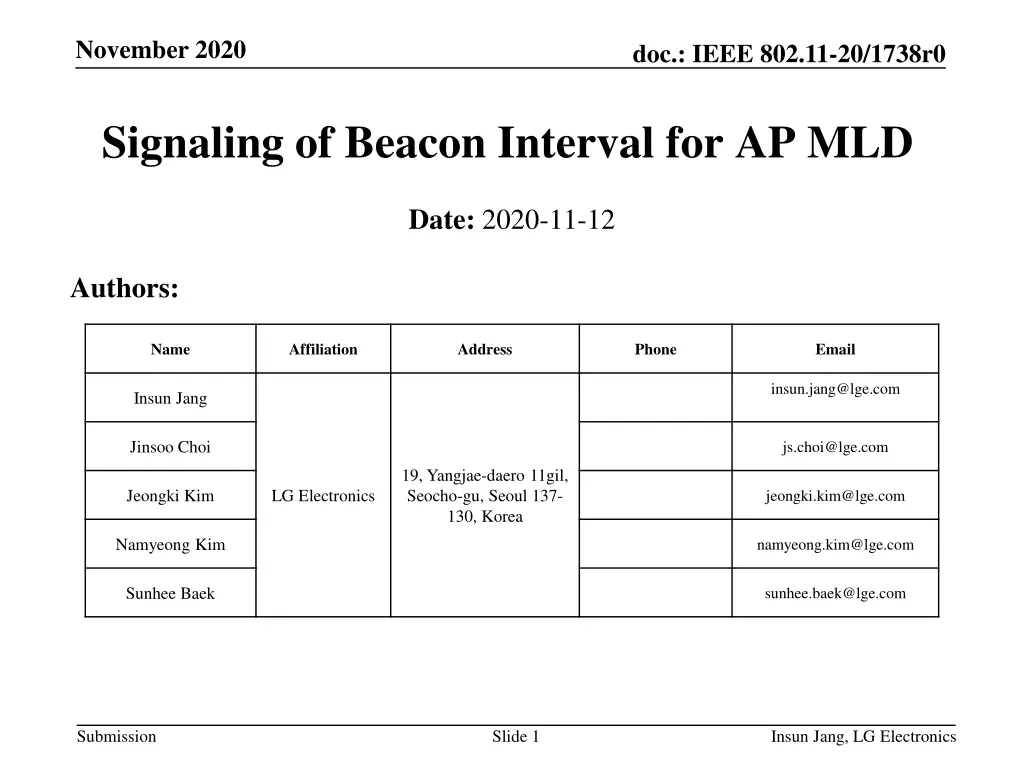
Signaling of Beacon Interval for AP MLD in IEEE 802.11-20 Standard
Explore the signaling mechanisms for Beacon Interval (BI) in Access Point (AP) Multi-Link Discovery (MLD) scenarios according to IEEE 802.11-20 standard. The document delves into how to indicate BI of other APs, the overview of signaling procedures, and options for BI signaling during basic discovery.
Download Presentation

Please find below an Image/Link to download the presentation.
The content on the website is provided AS IS for your information and personal use only. It may not be sold, licensed, or shared on other websites without obtaining consent from the author. If you encounter any issues during the download, it is possible that the publisher has removed the file from their server.
You are allowed to download the files provided on this website for personal or commercial use, subject to the condition that they are used lawfully. All files are the property of their respective owners.
The content on the website is provided AS IS for your information and personal use only. It may not be sold, licensed, or shared on other websites without obtaining consent from the author.
E N D
Presentation Transcript
November 2020 doc.: IEEE 802.11-20/1738r0 Signaling of Beacon Interval for AP MLD Date: 2020-11-12 Authors: Name Affiliation Address Phone Email insun.jang@lge.com Insun Jang Jinsoo Choi js.choi@lge.com 19, Yangjae-daero 11gil, Seocho-gu, Seoul 137- 130, Korea Jeongki Kim LG Electronics jeongki.kim@lge.com Namyeong Kim namyeong.kim@lge.com Sunhee Baek sunhee.baek@lge.com Submission Slide 1 Insun Jang, LG Electronics
November 2020 doc.: IEEE 802.11-20/1738r0 Introduction We have agreed that The value of the Listen Interval field sent by the non-AP MLD is in units of the maximum value of beacon intervals corresponding to the links that the non-AP MLD intends to setup in R1 [1] To this end, an STA of non-AP MLD shall know beacon intervals (BI) corresponding to the links that the non-AP MLD intends to setup In this contribution, we discuss how to indicate the beacon intervals of other APs Submission Slide 2 Insun Jang, LG Electronics
November 2020 doc.: IEEE 802.11-20/1738r0 Overview of Signaling of Beacon Intervals STA A discovers AP 1 (as reporting AP) and obtains Beacon Intervals of AP 2, 3 (as reported APs) Submission Slide 3 Insun Jang, LG Electronics
November 2020 doc.: IEEE 802.11-20/1738r0 BI Signaling During Basic Discovery A reporting AP can provide BIs of reported APs, as follows Option 1: RNR element Based on D0.1, the partial information of reported APs shall be provided by RNR IE (i.e., MLD ID, Link ID, Change Sequence) Therefore, the RNR element can be a proper candidate E.g., adding to MLD Parameters subfield of TBTT Information field (e.g., 2 octets) However, except other APs in the same MLD, BIs of some APs (such as non-transmitted BSSIDs in the same MBSSID set and APs of the same AP MLD as each non-transmitted BSSID) may be unnecessary Submission Slide 4 Insun Jang, LG Electronics
November 2020 BI Signaling During Basic Discovery (Cont d) doc.: IEEE 802.11-20/1738r0 Option 2: ML element By default, ML IE needs to include BIs of reported APs Based on D0.1 An AP within an AP MLD should include in the Beacon and non-ML Probe Response frames only the MLD-level/common information carried in the field(s) of ML IE Whether the multi-link element is always present in the Beacon and non-ML Probe Response frames or is optionally present is TBD Therefore, if ML IE includes BIs of reported APs, it should be in the Common part not Per-STA profile However, that is not common information and it requires ML IE is always present in Beacon and Probe Response frames Order of Link ID Submission Slide 5 Insun Jang, LG Electronics
November 2020 BI Signaling During Basic Discovery (Cont d) doc.: IEEE 802.11-20/1738r0 Option 3: New element We can define a new element carried in Beacon or Probe Response frame The new element should be for reported APs in the same AP MLD as reporting AP If an STA is not affiliated with an MLD, it does not need to include the new element in Beacon or Probe Response frame However, since we already have RNR element and ML element to signal the information regarding Multi-link, we may not need a new element to signal a specific ML information Order of Link ID Submission Slide 6 Insun Jang, LG Electronics
November 2020 doc.: IEEE 802.11-20/1738r0 Discussion on BI Signaling during MLD Probing An STA can request BIs of reported APs of the same AP MLD as the reporting AP using ML IE For example, through Request IE in Per-STA Profile of ML IE (assuming BI can be made as an element) The reporting AP can provide the requested BIs using ML IE However, if the STA perform MLD probing to obtain BIs of reported APs, MLD probing should be mandatory We believe MLD Probing is an optional mechanism Submission Slide 7 Insun Jang, LG Electronics
November 2020 doc.: IEEE 802.11-20/1738r0 Summary In this contribution, we discussed how to indicate the beacon intervals of other APs In terms of Basic Discovery, reporting AP can provide BIs of reported APs IE Location Issues MLD Parameters subfield* (in TBTT Information field) Consideration for APs (e.g., non-transmitted BSSID) (except for APs in the same AP MLD as reporting AP) RNR Validation of including in Common Part Whether ML IE is always present in Beacon Multi-link Common Part New Body of Beacon/Probe Response Necessity of another IE for ML information *Another (new) subfield could be used In terms of MLD Probing, if the STA perform MLD probing to obtain BIs of reported APs, MLD probing should be mandatory We believe MLD Probing is an optional mechanism Slide 8 Submission Insun Jang, LG Electronics
November 2020 doc.: IEEE 802.11-20/1738r0 References [1] 802.11-19/1262r20 Specification Framework for TGbe [2] IEEE P802.11be/D0.1, September 2020 Submission Slide 9 Insun Jang, LG Electronics

